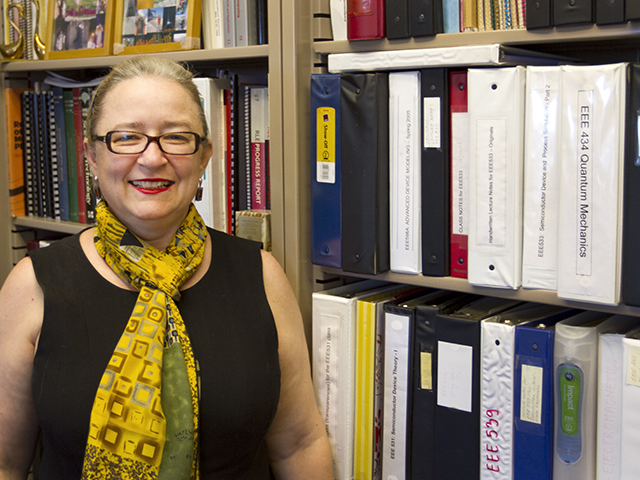
Vasileska will lead SunShot project to make solar cells more durable

ASU electrical engineer Dragica Vasileska will lead a project supported by the Department of Energy aimed at making solar energy technology more reliable. Photo: Jessica Hochreiter/ASU
A national project to improve the reliability of the photovoltaic cells used in solar energy systems will be led by an Arizona State University electrical engineer.
Through its SunShot Initiative, the U.S. Department of Energy has awarded a grant of $1.8 million over three years to a research team headed by Dragica Vasileska, a professor in the School of Electrical, Computer and Energy Engineering, one of ASU’s Ira A. Fulton Schools of Engineering.
The project is one of several research efforts supported by the SunShot Initiative to develop ways to produce stronger components that provide more dependable performance from solar energy technology.
Vasileska’s team will focus on comprehensively addressing the problem of metastabilities in cadmium telluride solar cells, via “first-principle calculations, solution of a diffusion-reaction set of equations and experimental verification,” she says.
The project involves the development of one-dimensional and two-dimensional unified solvers for solution of the diffusion-reaction equations that mitigate migration of point defects and grain boundaries in the materials of which solar cells are used.
Heat, cold, moisture, humidity and other environmental and atmospheric conditions cause cell materials to degrade and system performance to decline, Vasileka explains.
The chemical reactions involved in the workings of solar cells and the wear and tear on cells caused by environmental conditions combine to cause defects in the active device region.
Vasileska’s team must learn more about the mechanisms that drive defect formation in the materials, so that methods can be designed to prevent formation of defects harmful to solar cell performance.
The researchers will focus on cadmium sulfite and cadmium telluride materials, which have been shown to be particularly effective for fabrication of thin-film solar cells.
Vasileska’s co-leader on the project is engineer Igor Sankin, manager of the device physics group for Tempe, Arizona-based First Solar, one of the world’s largest manufacturers of thin-film solar cells.
They will collaborate with Christian Ringhofer, a professor in the School of Mathematics and Statistical Sciences in ASU’s College of Liberal Arts and Science, and with James Sites, a professor of physics at Colorado State University, and Su-Huai Wei, a physicist with the National Renewable Energy Laboratory.
The endeavor will be an affiliate project of the Quantum Energy and Sustainable Solar Technology (QESST) Engineering Research Center at ASU. The center, supported by the National Science Foundation and the Department of Energy, focuses on solving challenges to producing electricity from solar power in more technologically efficient and economically viable ways.
Media Contact:
Joe Kullman, [email protected]
(480) 965-8122
Ira A. Fulton Schools of Engineering



































